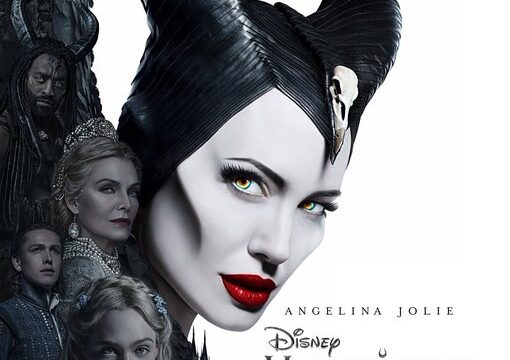Another live-action Disney remake, cool! We haven’t gotten any of those this year. Despite being like the umpteenth slice of chocolate cake eaten at an all-you-can-eat dessert buffet, Maleficent: Mistress of Evil actually stands out as narrowly the best of these movies we’ve gotten in 2019. Though still just average as a movie itself, it’s got more energy to it than Dumbo or The Lion King and both its production design and costume design stand out as genuinely enjoyable. It’s a pity the script is a mess by, among a number of critical faults, failing to deliver on elements general family audiences would want to see if they’re shelling out cold hard cash to see a Maleficent movie.
What’s the plot this go-around? Well, Maleficent (Angelina Jolie) follows up on the events of the first Maleficent that revealed the traditional Sleeping Beauty story is a lie, Maleficent is actually a misunderstood protagonist who became a mother figure to Aurora (Elle Fanning) after initially placing a curse on her. With all of that out of the way, Maleficent: Mistress of Evil begins with Maleficent still being feared by the general populace and Aurora getting a marriage proposal from Prince Phillip (Harris Dickinson). Maleficent does not approve of this idea, Phillip, after all, is a human and humans that aren’t Aurora cannot be trusted. But she tries to go along with it, which includes showing up for dinner with Phillip’s mother, Queen Ingrith (Michelle Pfieffer).
It’s made clear from the outset that Ingrith has her own evil plans to enact (you can tell this because she enters her secret evil lair by snapping a mannequin’s neck) that involve separating Maleficent and Aurora and starting up a war between humans fantasy creatures. Unlike most live-action remakes of animated Disney movies, Maleficent: Mistress of Evil has no classic animated movie to adhere to as a restrictive blueprint, it’s free to go off on its own tangents and storylines. This freedom means that the screenwriters have decided to dedicate a surprisingly large amount of screentime to explaining the lore of the fairy species Maleficent belongs to. Turns out, she’s not the only one of her kind, in fact, there’s different kinds of her species of fairies for each region on the planet.
That’s a nifty idea that yields an array of visually interesting looking fairies while their hideaway home that manages to include all kinds of different types of biomes (a desert, a jungle, the Tundra, etc.) is extremely imaginative. Unfortunately, all of this backstory takes up way too much of the second-act and means Maleficent spends a large chunk of her second solo movie stuck just listening to Conall (Chiwetel Ejiofor) prattle on about fairy mythos rather than doing things you’d actually associate with her character. Why couldn’t Maleficent be a more active character in her own movie? What a puzzling decision that’s almost as baffling as Aurora’s conflict between acting more human and more fantastical that comes and goes in the span of 90 seconds.
A climactic duel between fairies and humans is also ineffective in execution, despite hopping back-and-forth between so many different perspectives, there’s just no engaging human drama to ground the proceedings, it just becomes a mish-mash of CGI yelling at other CGI things. Sometimes there’s moments of weirdness or hamminess to liven it up (Maleficent technically goes Super-Saiyan in this climax and it’s certainly something), but there’s nowhere near enough of it to compensate for how dramatically inert it all is. The only real advantage to having this loud climax finish up the movie is that it’s amusing how Maleficent: Mistress of Evil started out as a Guess Whose Coming to Dinner pastiche before finishing up as a J.R.R. Tolkien knock-off.
Director Joachim Ronning (who previously helmed the fifth Pirates movie and Kon-Tiki) is going through the motions in many respects here, much of the movie, whether it’s in Aurora being surrounded by happy woodland critters or the forgettable antics of a CGI porcupine/human sidekick, feels quite derivative of other movies. When Ronning does show flashes of distinct identity in his filmmaking, though, there is some fun to be had. At one point, Maleficent wakes up in a fairy nest that totally looks unlike any other location in the film and Ronning seems to be relishing the chance to capture a domain that isn’t beholden to what came around in the first Maleficent movie.
The production design and costume work in Mistress of Evil are actually its best qualities, the various new strains of human-sized fairies are especially lovely looking with their distinct designs and bright colors. A whole bunch of well-done practically-realized sets help to lend some tangibility to the ultra-fantastical proceedings, particularly a richly detailed hideaway for the conniving Lickspittle (played by the always welcome Warwick Davis) full of enjoyable nooks and crannies. The humans inhabiting those sets, though, get very little to do, despite being played by an assortment of terrific actors. Michelle Pfieffer fares the best out of all of them with her wickedly fun performance, she’s the stand-out feature in a frequently disposable fantasy film like Maleficent: Mistress of Evil.

